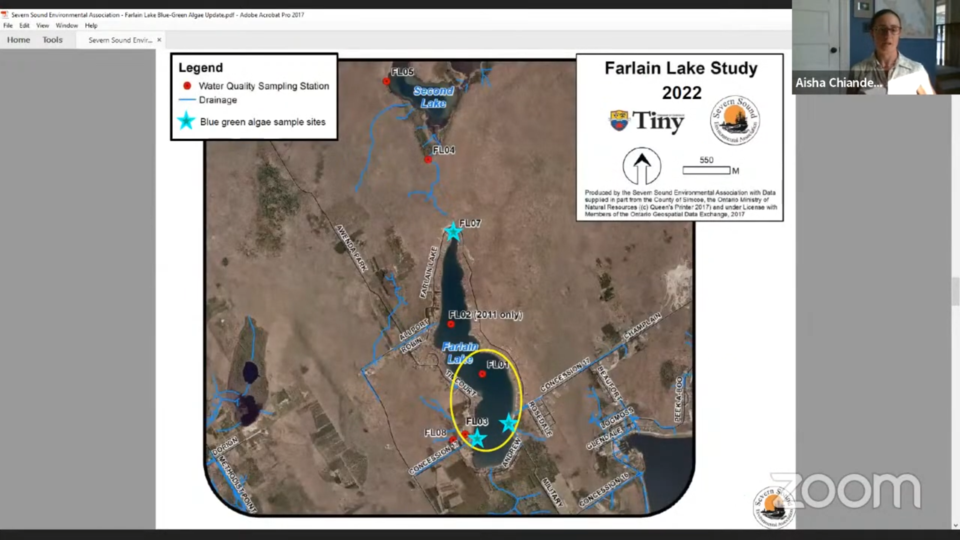There were no easy answers to explain the ongoing blue green algae bloom at Farlain Lake in Tiny Township.
Aisha Chiandet, water scientist for the Severn Sound Environmental Association (SSEA), provided a report to Tiny council at a recent committee of the whole meeting.
The problematic bloom in Farlain Lake was a result of blue green algae, also known as cyanobacteria, which was first observed by SSEA staff during routine sampling and a report to the Ministry of Environment, Conservation & Parks (MECP).
“They then followed up with taxonomic and toxin analysis which showed the presence of three types of blue green algae and also detectable levels of the toxin microcystin. Levels of the toxin were below the recreational contact limit (20 µg/L), but they were above the drinking water limit (1.5 µg/L) so the health unit issued a water quality advisory at that point,” stated Chiandet.
“MECP resampled a week later after the initial observation, and while toxin levels have come down substantially, the advisory remains in place while the bloom is still active.”
Of the three bacterial species present in the bloom, two had appeared in prior lake surveys going back to 1996. The third, gloeotrichia, had been present in the most recent survey of 2016, and was the dominant species in this year’s bloom.
Reasons for the bloom were complex and unknown, according to Chiandet, but best guesses were made based on data collected, analyzed, and compared to previous years. Potential reasons for the causes included: an increase in ice-free days in recent years; a warmer start to 2022; and a heat wave and storm event which could have brought in nutrients preceding the bloom.
Additionally, an under-ice sampling in 2020 revealed a higher-than-normal amount of phosphorus concentration, the main nutrient for gloeotricia, above the lake bottom with potential higher amounts within the sediment itself.
Chiandet added that steps can still be taken by area residents to minimize the growth, through maintaining septic systems, eliminating fertilizer use, maintaining a natural shoreline, reducing runoff, and reducing erosion through activities such as boat wakes.
Council asked questions toward possible causes.
Coun. Gibb Wishart inquired about the runoff of septage across agricultural fields, but was informed that wind conditions played a large role especially on the south side with the highest accumulation.
“When you’re looking at locations of where the blooms are occurring,” said Chiandet, “because it’s such a small lake and very well-mixed by the wind, where we’re seeing bloom accumulations is more related to where the wind is pushing the algae.”
The topic of lake test frequency was broached by Coun. Cindy Hastings as well as Deputy Mayor Steffen Walma.
A parks and recreation advisory committee motion to review monetary considerations in the 2023 budget for the matter was forwarded to look into by staff. Likewise, council considered having water quality surveys done on Farlain Lake annually instead of every five years until the bloom was deemed to be under control.
Mayor George Cornell described the presentation as clear, concise, comprehensive, “and relatively simple for folks to understand… in what your key observations are; and some of your suggestions on how we can monitor and use better practices going forward to manage this situation.”
Chiandet also informed residents that while not all blooms contain toxins, it is best to practice safety and presume toxins are present until informed otherwise.
“Because of this potential health implication, it’s important to report any suspected blooms to the Spills Action Centre (1-866-663-8477),” advised Chiandet.
Individuals affected by blue green algae are strongly recommended to seek medical attention if symptoms such as skin, eye or throat irritation, allergic reactions or breathing difficulties occur following contact with the blue-green algae bloom. Anyone who comes into contact with blue-green algae should wash with soap and water or rinse thoroughly with clean water. Swimming, bathing or showering with water not visibly affected by a blue-green algae bloom is not expected to cause health effects.
Updates on the current bloom conditions of Farlain Lake can be found on the Tiny Township website.
The Severn Sound Environmental Association presentation on blue green algae at Farlain Lake can be viewed within the agenda page located on the Tiny Township website.
Archives of council meetings are available to view on Tiny Township’s YouTube channel.
